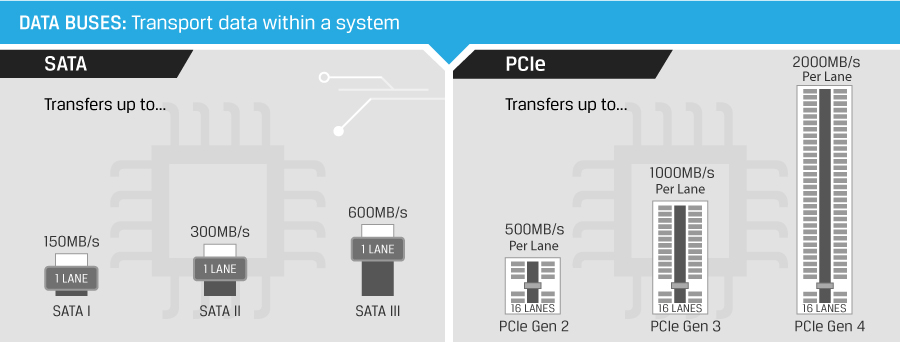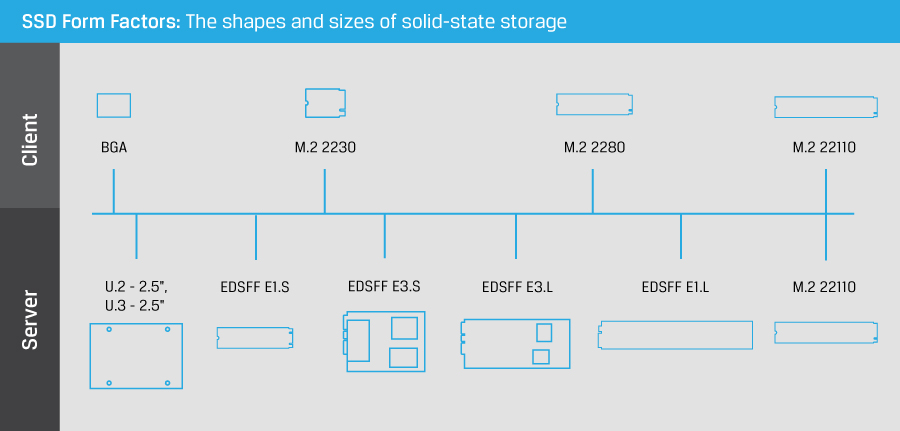Ask an Expert
Planning the right solution requires an understanding of your project and system requirements. Let Kingston's experts guide you.
Ask an Expert
NVMe technology provides superior storage, superior speed and superior compatibility. Because NVMe utilizes PCIe sockets, it transfers 25x more data than the SATA equivalent. Along with more data, NVMe’s commands are 2x faster than that of AHCI drivers. In addition, NVMe input/output operations per second (IOPS) exceeds 1 million and is up to 900% faster compared to AHCI drives. NVMe also communicates directly with the system CPU giving it incredible speeds due to its compatibility. NVMe drives work with all major operating systems regardless of form factor.

The NVMe protocol utilizes parallel, low-latency data paths to the underlying media like high performance processor architectures. This offers significantly higher performance and lower latencies compared to SAS and SATA protocols. NVMe can support multiple I/O queues, up to 64K with each queue having 64K entries. This allows input/output tasks to transfer more data faster than older storage models using legacy drivers such as AHCI (Advanced Host Controller Interface). Because NVMe is designed specifically for SSDs, it will eventually become the new industry standard.

Data buses transfer data within a system and when NAND-based SSDs first came out, it was clear to the industry that a new bus and protocol were necessary.
The decision to leverage an existing higher-bandwidth bus technology replaced SATA protocols with PCIe technology. PCIe storage came before NVMe by a few years but since previous solutions were bottlenecked by older data transfer protocols such as SATA and AHCI, it couldn’t be used to its full potential until recent years. NVMe was the solution for the bottlenecks and removes limitations by offering low-latency commands and 64K queues. The multiple queues allow faster data transfers because data is written to SSDs in a scattered fashion using chips and blocks rather than being written on spinning disks like hard drives.
Communication drivers are used by operating systems to communicate data with storage devices. NVMe drivers are faster than AHCI drivers which are commonly found in SATA interfaces.
The NVMe driver communicates directly with the system CPU but the AHCI must communicate with the SATA controller. The AHCI has IOPS (Input/Output Operations Per Second) up to 100K while the NVMe has IOPS over 1 million. IOPS (Input/Output Operations Per Second, pronounced i-ops) is a common performance measurement used to benchmark computer storage devices.


NVMe SSDs come in a variety of form factors but they get specific depending on the use case or application.
There are developing standards and efforts within the EDSFF (Enterprise and Data Center SSD Form Factor) which offers a dynamic range of form factors and standards that share the same protocol (NVMe), the same interface (PCIe), and use their own edge connector (SFF-TA-1002), pinout and functions (SFF-TA-1009).
#KingstonIsWithYou

Planning the right solution requires an understanding of your project and system requirements. Let Kingston's experts guide you.
Ask an Expert
So you want to drastically improve the speed of your PC with an SSD upgrade. But how do you choose?